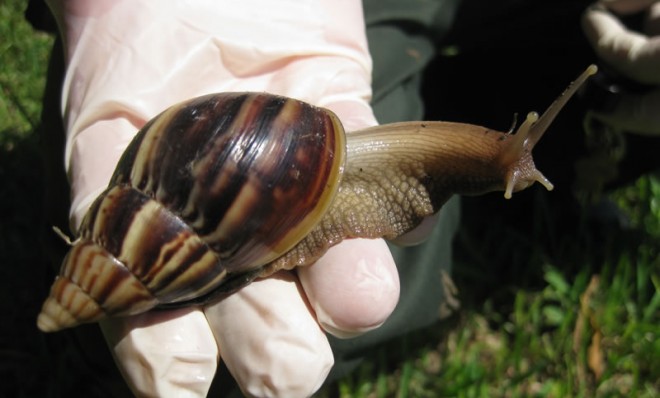
Watch: the giant, rat-sized snails devouring south florida
- Select a language for the TTS:
- UK English Female
- UK English Male
- US English Female
- US English Male
- Australian Female
- Australian Male
- Language selected: (auto detect) - EN
Play all audios:
South Florida is under attack, and the non-native species threatening to wreak havoc seems innocent enough: It's not the giant Burmese pythons that made a home in the Everglades in
2000, nor a ravenous, land-walking fish like the Asian carp that have been eating through waterways farther up north. No, this foreign invader is a snail. But what a snail it is. The giant
African land snail "can grow as big as a rat and gnaw through stucco and plaster," says _Reuters_' Barbara Liston. Since the monstrous mollusks were first noticed in the
Miami-Dade County area in September 2011, researchers and vigilant homeowners have caught at least 117,000 of them, or about 1,000 a week. And "residents will soon likely begin
encountering them more often, crunching them underfoot as the snails emerge from underground hibernation at the start of the state's rainy season in just seven weeks." SUBSCRIBE TO
THE WEEK Escape your echo chamber. Get the facts behind the news, plus analysis from multiple perspectives. SUBSCRIBE & SAVE SIGN UP FOR THE WEEK'S FREE NEWSLETTERS From our
morning news briefing to a weekly Good News Newsletter, get the best of The Week delivered directly to your inbox. From our morning news briefing to a weekly Good News Newsletter, get the
best of The Week delivered directly to your inbox. Just how big and bad are these slow-moving menaces? "The largest stretch 8 inches," says Zack Peterson in the _Ocala StarBanner_.
"The oldest live nine years. The busiest lay up to 1,200 eggs" a year. They eat at least 500 species of plants, plus the stucco and plaster that provide calcium for their shells.
And if that's not disturbing enough, the snails "even carry a parasitic nematode that can lead to meningitis in humans" — though no cases of the pathogen, rat lungworm, have
been found among humans in the U.S. yet. (Watch raw footage of the snails below.) They sound like "monsters from hell sent to punish us," or at least Florida, says Michael Ballaban
at _Jalopnik_. But "perhaps the worst part of the invading monster snails is that if you hit one on the highway their shells are hard enough to cause a blowout." They can also
turn deadly when a lawnmower hits one, flinging the shell out at high velocity. And then there's the slime trails they leave everywhere. "It becomes a slick mess," Denise
Feiber, a spokeswoman for the Florida Department of Agriculture and Consumer Services, tells _Reuters_. This isn't Florida's first battle with the giant African land snail. The
Sunshine State won the last war — in the 1960s, after a boy brought three snails home from Hawaii — but it wasn't cheap or easy. Those three snails turned to 17,000 in seven years, and
beating them took 10 years and $1 million. "Feiber said she doesn't want this eradication project to last that long," reports the _StarBanner_'s Peterson. So last week,
her department held a strategy roundtable with experts from across the U.S. and Canada. How did _this_ invasion start? "One possibility being examined is a Miami Santeria group, a
religion with West African and Caribbean roots, which was found in 2010 to be using the large snails in its rituals," says _Retuers_' Liston. Or somebody could have brought them in
as pets, like in 1966. Or it could have just been an accident, like this decidedly unsavory possibility: A free daily email with the biggest news stories of the day – and the best features
from TheWeek.com Miami-Dade is ground zero, but "unfortunately, the invasion is not limited to Florida," says Josh Mogerman in the _Chicagoist_. These "ticking environmental
time bombs" have been found in upper Midwestern schools, pet shops, and even one private breeder's operation. And it would only take one escaped or released snail to spark a new
infestation, Feiber tells _Reuters_: